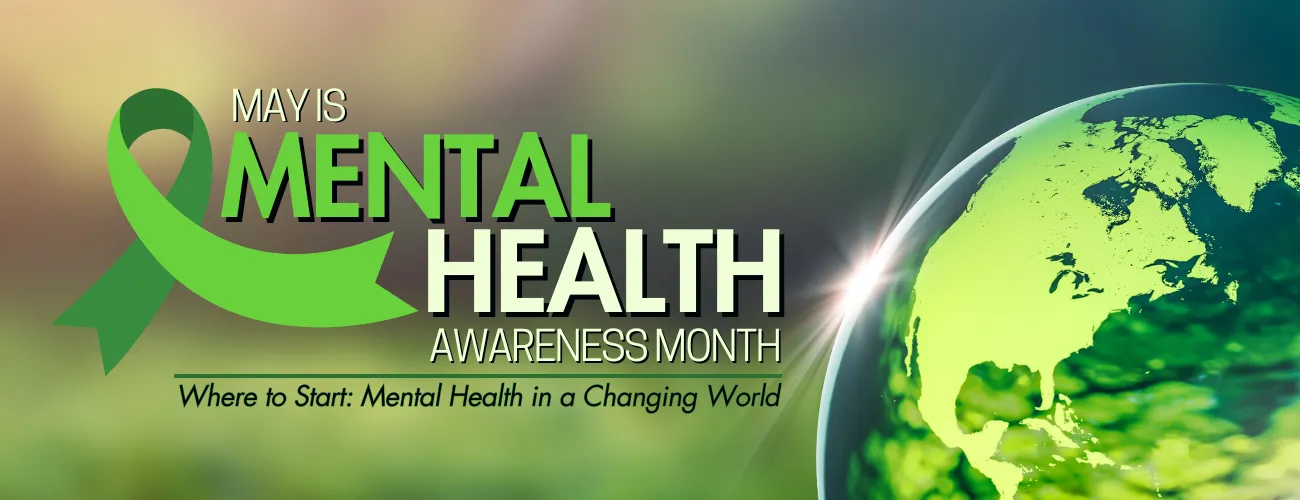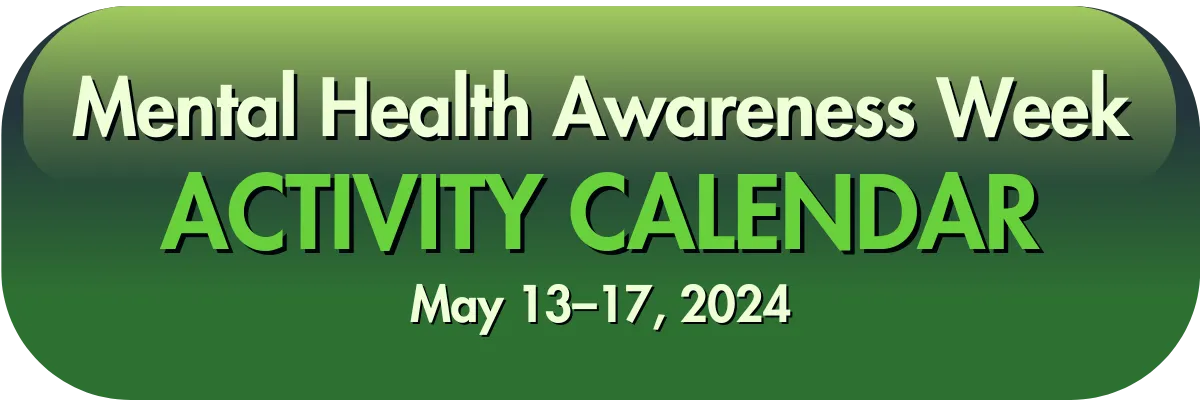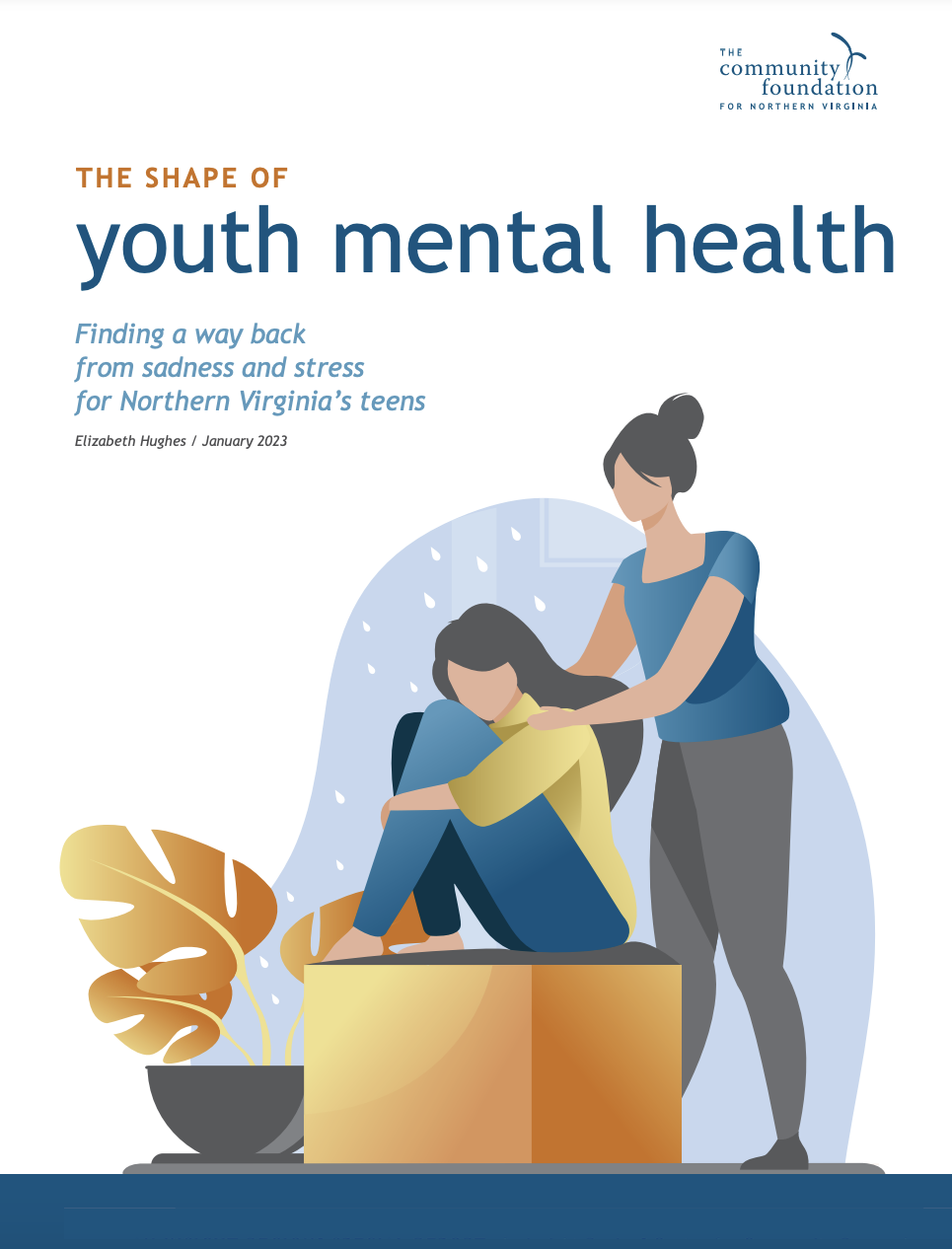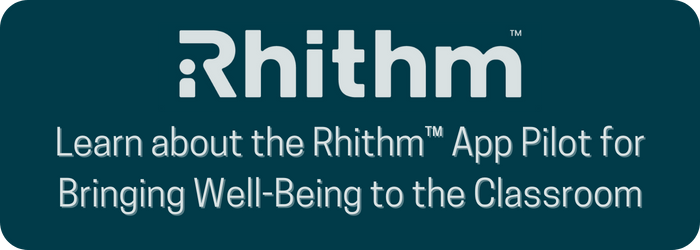
May is Mental Health Awareness Month
In partnership with Mental Health America, PWCS recognizes May as Mental Health Awareness Month and is dedicated to prioritizing our well-being and promoting open conversations about mental health. This year's message is "Where to Start: Mental Health in a Changing World." Navigating the ever-changing world can be challenging, especially when it comes to prioritizing mental health. Life's pressures can be overwhelming, and everyone deserves to be supported and empowered to seek help when needed. While society is getting more comfortable discussing mental health, it can still be hard to know #WhereToStart when it comes to taking care of ourselves.
Throughout May, various events and initiatives to raise awareness are taking place in our schools to encourage self-care and recognize the importance of mental health and its impact on our lives. Families are encouraged to participate in these activities and use the available resources to support one another.

Fast Facts
- 1 in 5 U.S. adults experience mental illness each year
- 1 in 20 U.S. adults experience a serious mental illness each year
- 1 in 6 U.S. youth aged 6–17 experience a mental health disorder each year
- 50% of all lifetime mental illness begins by age 14, and 75% by age 24.
- Suicide is the 2nd leading cause of death among people aged 10–14
- People with depression have a 40% higher risk of developing cardiovascular and metabolic diseases than the general population
- High school students with significant symptoms of depression are more than twice as likely to drop out compared to their peers
- 1 in 5 young people report that the pandemic had a significant negative impact on their mental health.
- Students aged 6-17 with mental, emotional or behavioral concerns are 3x more likely to repeat a grade.
Retrieved from National Alliance on Mental Health
Source: Data from CDC, NIMH and other select sources.
Find citations at nami.org/mhstats
Family Resources
Fact Sheets and Poster
- Mental Health America (MHA)
Help for Mental Health and Other Treatment
- Substance Abuse and Mental Health Services Administration (SAMHSA)
- National Alliance on Mental Illness
- National Institutes of Health (NIH)
- Choices worksheet (PDF)–Organize and compare what you learn about different providers and to make a choice.
Articles
- Current Priorities of the U.S. Surgeon General
- Outdoor Light Linked with Teens' Sleep and Mental Health–National Institute of Mental Health (NIMH)
- Things You Can Do to Improve Your Child's Mental Health–Verywell Family
- Surgeon General Issues New Advisory About Effects Social Media Use Has on Youth Mental Health, May 23, 2023–U.S. Department of Health and Human Services
- What Every Child Needs for Good Mental Health–Mental Health America (MHA)
- What Is Children's Mental Health?–Centers for Disease Control and Prevention (CDC)
- What to Do if You're Concerned About Your Teen's Mental Health (PDF) –The JED Foundation
- Youth Connectedness Is an Important Protective Factor for Health and Well-being –CDC
Online Presentation
- Kids and Social Media: The Good, the Bad, and the Ugly (Robyn Mehlenbeck, PhD, George Mason University, recorded February 24, 2024) Enter the following passcode: =j9xkX6#
Publications
|
|
|
Getting Started with Mental Health Treatment: What You Need to Know by Heather Moul, LCSW, School Social Worker, PWCS I think I (or my child) would like to talk to someone. What should I know? What do I do next? How do I find a therapist? Who are therapists and what do they do? If you have private insurance, call your insurance company and check for your Behavioral Health Benefits. Most people assume their medical benefits are the same as their behavioral health benefits but often they are not. Most solo or group mental health practices DO NOT check your benefits like a medical practice. Therefore, if the solo/group practice files a claim and it gets rejected you may be responsible for the full rate (self-pay or out of cost pocket) cost. Here is what to ask your insurance company about your behavioral health benefits:
If you do not have mental health benefits or have no insurance, you still have options. Contact the Community Services Board (CSB) or your local church, as some pastors provide pastoral counseling. Most mental health therapists also take self-pay, charge on sliding scale or pro bono. Another option is to contact a mental health practice and ask if they have interns on staff who charge lower fees. What are the different types of therapists who can diagnose and provide treatment for mental health disorders?
|
Toolkits for Schools
- Mental Health America
- National Alliance on Mental Illness (NAMI)
- Follow These Steps to Ease Student Anxiety in Your Classroom–Hey Teach!
Resources to Support the Mental Health of Teachers and School Staff
- Angela Watson's Truth for Teachers Podcast–Weekly podcasts providing encouragement and inspiration for teachers. Ranks in the top three K-12 podcasts in the world.–The Cornerstone for Teachers.
- Care for the Caregiver: Guidelines for Administrators and Crisis Teams–National Association of School Psychologists (NASP).
- Current Priorities of the U.S. Surgeon General
- Employee Benefits–PWCS, in coordination with our Employee Assistance Program ComPsych Guidance Resources, offers workshops and toolkits for enhanced wellbeing. May's offerings are mental health-based and June's are focused on summer fun. For links and webinar registration, visit the Employee Benefits page.
- Teacher Mental Health Tips You Can't Afford to Ignore–Teach Starter
- The Educator's Room Presents: The Teacher Self-Care Podcast–Anchor by Spotify.
- Why Teacher Self-Care Matters and How to Practice Self-Care in Your School–Waterford.org.
- Enroll in the Self-Care and Wellness Canvas Course
Webinars and Videos
| 10 Common Warning Signs of a Mental Health Condition ~National Alliance on Mental Health (NAMI)~ (YouTube Video) |
| Being More Intentional About Our Mental Health ~Mental Health America (MHA)~ (YouTube Video) |
| Engaging Youth in Safe Online Spaces to Address Mental Health Concerns ~Mental Health America (MHA)~ (YouTube Video) |
|
Where to Get Help
Where to Get Help
- 988 - Suicide & Crisis Lifeline - Dial or text 988 or visit the 988 webpage if you or someone you know is having thoughts of suicide or experiencing a mental health crisis and get connected to a trained crisis counselor 24 hours a day, 7 days a week. Crisis counselors listen empathetically and without judgment. Your crisis counselor will work to ensure that you feel safe and help identify options and information about mental health services in your area.
- Prince William County Crisis Intervention Services are available 24 hours a day, 7 days a week: If you or someone you know is at risk of harm or in a mental health crisis but is not in immediate danger, call 703-527-4077 or text CONNECT to 85511. If there is immediate danger, go to the nearest hospital emergency department or call 911.
- Crisis Text Line – Text HOME to 741741 to connect with a trained crisis counselor to receive free, 24/7 crisis support via text message.
- National Domestic Violence Hotline – Call 800-799-SAFE (7233) - Trained expert advocates are available 24/7 to provide confidential support to anyone experiencing domestic violence or seeking resources and information. Help is available in Spanish and other languages.
- National Sexual Assault Hotline – Call 800-656-HOPE (4673) - Connect with a trained staff member from a sexual assault service provider in your area that offers access to a range of free services. Crisis chat support is available.
- Tip Line: Information about drugs, weapons, or other factors which may be harmful to the school environment should be reported via the Tip Line or through the "Say Something" Anonymous Reporting System (SS-ARS). SS-ARS is designed specifically for students in grades 6-12 and staff to report any serious or potentially violent concerns of unsafe behavior or threats of harm to self or others. "Tipsters" can send reports on anything from school threats they've seen or overheard to personal crises, including sexual harassment, self-harm, and depression.
- Submit an anonymous tip by calling 1-844-5-SAYNOW or visiting www.SaySomething.net
- Call 911 in cases of immediate emergency
- Reach out to your health insurance, primary care doctor or state/county mental health authority for more resources.
- Talk with your employer about their Employee Assistance Program (EAP). These programs typically extend coverage to your immediate family members including children.
- National Alliance on Mental Illness (NAMI), Prince William Chapter, offers free support groups.
- NAMI Family Support Groups - NAMI Family Support Groups are free, confidential and safe groups of families helping other families who live with mental health challenges by utilizing their collective lived experiences and learned group wisdom.
- NAMI Connection - NAMI Connection is a weekly recovery support group for people living with mental illness in which people learn from each others’ experiences, share coping strategies, and offer each other encouragement and understanding.
Mental Health Awareness Month Resolution–Approved May 3, 2023
WHEREAS, mental health is essential to everyone’s overall health and well-being; and
WHEREAS, everyone experiences times of difficulty and stress throughout their lives, and one in five adults struggles to address a mental health issue in any given year; and
WHEREAS, people with mental illnesses make important contributions to their families and our communities; and
WHEREAS, early detection effectively reduces the burden of mental health conditions on individuals and their families; and
WHEREAS, with early and effective treatment, individuals who suffer with mental health conditions can recover and lead full, productive lives; and
WHEREAS, research supports specific tools like connecting with others, being physically active, and seeking professional help if needed to assist anyone to better handle challenges and protect their health and well-being; and
WHEREAS, mental health conditions are real and prevalent in our nation, but stigma and fear of discrimination keep many who would benefit from mental health services from seeking help; and
WHEREAS, every business, school, government agency, health care provider, organization, and citizen shares the burden of untreated mental health conditions and benefits greatly from promoting wellness and supporting prevention efforts.
NOW, THEREFORE BE IT RESOLVED that the Prince William County School Board and the Superintendent of Schools recognize May 2023 as “Mental Health Awareness Month” to enhance public awareness of the importance of positive mental health and in particular, youth mental health.
The Wellness Continuum
The Path to Self-Care and Well-Being: Understanding the Wellness Continuum

The wellness continuum is a concept that provides a framework for assessing and understanding various aspects of our well- being across different dimensions of life. It allows individuals, including families and students, to evaluate their emotional, physical, and mental health consistently by examining where they fall on the continuum.
The wellness continuum encompasses a wide range of factors that contribute to our overall well-being. These factors include our physical health and fitness, mental well-being, social connections, emotional stability, spiritual beliefs, occupational satisfaction, and overall physical condition
By considering these different dimensions, the wellness continuum helps us gauge our overall wellness and determine how well we function within each facet of our lives. It provides a holistic perspective, highlighting the interconnectedness of various aspects of our well-being.
The wellness continuum offers a valuable tool for self-assessment and self- reflection. Families and students can use this continuum to regularly check in on their emotional, physical, and mental health. By assessing where they fall on the continuum, individuals can gain insights into their strengths, areas for improvement, and the overall balance in their lives.
When using the wellness continuum, individuals can reflect on questions such as:
- Physical Health/Fitness: How well am I taking care of my body? Am I engaging in regular exercise, maintaining a balanced diet, and getting enough rest and sleep?
- Mental Well-being: How is my mental health? Am I managing stress effectively? Am I engaging in activities that promote mental relaxation and resilience?
- Social Connections: How are my relationships with family, friends, and the community? Am I nurturing supportive and meaningful connections? Do I have a strong support system?
- Emotional Stability: How well am I managing my emotions? Am I aware of and addressing my emotional needs? Am I practicing self-care and coping strategies to promote emotional well-being?
- Spiritual Beliefs: How connected do I feel to my spiritual beliefs or values? Am I engaging in practices that align with my spiritual well-being?
- Occupational Satisfaction: How fulfilled am I in my work or studies? Do I find meaning and purpose in my occupation or educational pursuits?
- Overall Physical Condition: Am I taking care of my overall physical health by attending to regular check- ups, addressing any medical concerns, and practicing preventive care?
By regularly assessing where they fall on the wellness continuum, families and students can identify areas that may require attention or improvement. This self-awareness can guide individuals in making informed decisions to enhance their overall well-being, contribute effectively to society, and nurture positive relationships and experiences.
It is important to note that the wellness continuum is not meant to be a rigid scale with fixed endpoints. It is a fluid concept that allows for growth, development, and ongoing self- improvement. By consciously considering the various dimensions of wellness, individuals can strive for balance, make positive lifestyle choices, and prioritize their overall well-being.
Author: Briana Milton | School Counseling Coordinator | College, Career, and Student Support Department

Creating Healthy Routines to Strengthen Your Mental Health

Creating Healthy Routines to Strengthen Your Mental Health
Adults and children are constantly overwhelmed each day by all they need to accomplish. We often forget to take time out to care for ourselves. A wonderful way to ensure that you build in time for yourself each day is to create healthy routines that become a pattern or habit that you just do without needing to think about them.
Below are six examples of simple activities to build into your day or week:
- Getting High Quality Sleep:
- Six hours or more per night is ideal–more for growing children.
- Avoid caffeine after 3 p.m.
- Try to make your place of sleep quiet and calm.
- Cut Back on Social Media:
- Social media can trigger individuals to compare themselves to others and increase anxiety.
- Turn off social media notifications.
- Make a list of alternatives to scrolling.
- Exercise:
- Movement can be something different for every person and does not require going to the gym.
- Movement can include a weekend hike, yardwork, stretching breaks, or throwing a dance party.
- Eating Nutrient-Rich Foods:
- Try mood-boosting nutrient-filled foods like berries, bananas, beans, and whole grains.
- Drink plenty of water.
- Avoid foods such as caffeine, refined carbs and added sugars when possible.
- Make Time for Rest:
- This may be different for each person but find something that gives your mind and body time to unwind and rest.
- Mindful breathing is one example.
- Get Outside:
- Being outdoors and in the sun can improve your mood and attitude.
- Try planning on eating a meal outside, taking a quick walk, or something as simple as opening a window.
Remember to try to start small by adding different activities to create healthier routines. Think about what you are already doing in your daily routine and swap to a healthier choice. Do not beat yourself up if you miss a part of your routine or even throw the entire day out the window. Remember that we must first be healthy ourselves to help our children get and remain healthy too.


